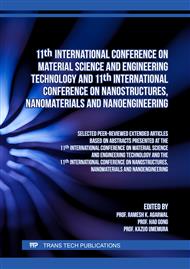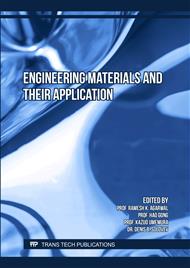[1]
Kanyanta V. Microstructure-Property Correlations for Hard, Superhard, and Ultrahard Materials / ed. Kanyanta V. Cham: Springer International Publishing, 2016. 239 p
DOI: 10.1007/978-3-319-29291-5
Google Scholar
[2]
Katoh Y. et al. Properties of zirconium carbide for nuclear fuel applications // J. Nucl. Mater. 441 (2013) 718–742
DOI: 10.1016/j.jnucmat.2013.05.037
Google Scholar
[3]
Niu B. et al. Effect of solid solution formation on densification of spark plasma sintered ZrC ceramics with TiC as sintering aid // Adv. Appl. Ceram. 115 (2016) 55–59
DOI: 10.1179/1743676115Y.0000000037
Google Scholar
[4]
Chicardi E. et al. Synthesis of all equiatomic five-transition metals High Entropy Carbides of the IVB (Ti, Zr, Hf) and VB (V, Nb, Ta) groups by a low temperature route // Ceram. Int. 46 (2020) 21421–21430
DOI: 10.1016/j.ceramint.2020.05.240
Google Scholar
[5]
Kan W.H. et al. Precipitation of (Ti, Zr, Nb, Ta, Hf)C high entropy carbides in a steel matrix // Materialia. 9 (2020)
DOI: 10.1016/j.mtla.2019.100540
Google Scholar
[6]
Wei X.F. et al. High entropy carbide ceramics from different starting materials // J. Eur. Ceram. Soc. 39 (2019) 2989–2994
DOI: 10.1016/j.jeurceramsoc.2019.04.006
Google Scholar
[7]
Wei X.F. et al. Gradient microstructure development and grain growth inhibition in high-entropy carbide ceramics prepared by reactive spark plasma sintering // J. Eur. Ceram. Soc. 40 (2020) 935–941
DOI: 10.1016/j.jeurceramsoc.2019.12.034
Google Scholar
[8]
Zhou J. et al. High-entropy carbide: A novel class of multicomponent ceramics // Ceram. Int. 44 (2018) 22014–22018
DOI: 10.1016/j.ceramint.2018.08.100
Google Scholar
[9]
Tan Y. et al. Oxidation behaviours of high-entropy transition metal carbides in 1200 °C water vapor // J. Alloys Compd. 816 (2020) 152523
DOI: 10.1016/j.jallcom.2019.152523
Google Scholar
[10]
Wang F. et al. Irradiation damage in (Zr0.25Ta0.25Nb0.25Ti0.25)C high-entropy carbide ceramics // Acta Mater. 195 (2020) 739–749
DOI: 10.1016/j.actamat.2020.06.011
Google Scholar
[11]
Chicardi E., García-Garrido C., Gotor F.J. Low temperature synthesis of an equiatomic (TiZrHfVNb)C5 high entropy carbide by a mechanically-induced carbon diffusion route // Ceram. Int. 45 (2019) 21858–21863
DOI: 10.1016/j.ceramint.2019.07.195
Google Scholar
[12]
Liu D. et al. Phase evolution and properties of (VNbTaMoW)C high entropy carbide prepared by reaction synthesis // J. Eur. Ceram. Soc. 40 (2020) 2746–2751
DOI: 10.1016/j.jeurceramsoc.2020.03.020
Google Scholar
[13]
X. F. Wei, J. X. Liu, F. Li, Y. Qin, Y. C. Liang, and G. J. Zhang. High entropy carbide ceramics from different starting materials // J. Eur. Ceram. Soc. 39 (2019) 2989–2994
DOI: 10.1016/j.jeurceramsoc.2019.04.006
Google Scholar



